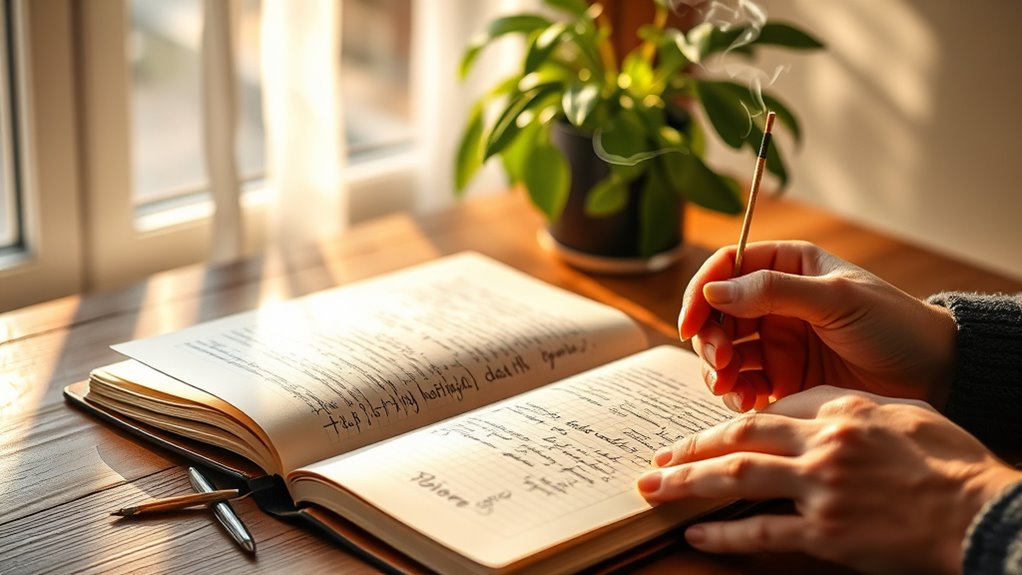Combining journaling and meditation helps you gain deeper insights into your thoughts and emotions. Meditation calms your mind and creates space to observe feelings without judgment, while journaling allows you to process and externalize those emotions. Together, they promote greater self-awareness and emotional clarity, making it easier to recognize patterns and triggers. Practicing both consistently can enhance your mindfulness skills and emotional growth—if you stay curious, you’ll discover how these tools can transform your self-understanding over time.
Key Takeaways
- Journaling after meditation helps externalize and clarify insights gained during mindfulness practice.
- Combining both enhances emotional awareness, enabling deeper understanding of inner experiences.
- Reflective journaling reinforces mindfulness, making emotional shifts more noticeable and meaningful.
- Meditation creates a receptive space for honest journal entries, fostering honest self-exploration.
- Together, they cultivate ongoing personal growth and improve emotional regulation through continuous reflection.

Journaling and meditation are powerful tools you can use to boost your mental clarity and emotional well-being. When you combine these practices, you create a synergy that deepens your understanding of yourself and enhances your mindfulness practices. By integrating journaling into your meditation routine, you open a pathway to clearer insights and a stronger connection with your inner experiences. This combination is particularly effective for cultivating emotional awareness, helping you recognize and process your feelings more consciously.
Combining journaling and meditation deepens self-understanding and enhances emotional awareness.
When you start your day with meditation, you set a calm, focused tone that quiets mental noise and allows you to observe your thoughts without judgment. Afterward, journaling acts as a bridge, capturing the insights, emotions, and reflections that arose during your meditative state. Writing down what you experienced helps solidify your awareness of your emotional landscape, making it easier to identify recurring patterns or triggers. This process supports mindfulness practices by encouraging you to stay present with your feelings rather than avoiding or suppressing them.
As you continue this routine, you’ll notice that your emotional awareness deepens. Meditation creates a receptive space where you can observe emotions with curiosity rather than reaction. When you journal, you articulate those emotions, giving them shape and context. This act of externalizing feelings makes them more tangible, allowing you to examine them objectively. Over time, this practice helps you develop a non-judgmental stance toward your emotional responses, which is a cornerstone of mindfulness.
Incorporating journaling into your meditation sessions also helps clarify your intentions and goals. After meditating, take a few moments to write about what you hope to explore or understand better. This focused journaling can guide your future meditations, making them more targeted and meaningful. As you repeatedly connect these practices, you become more attuned to subtle shifts in your emotional state, enhancing your overall mental clarity.
Additionally, understanding the effective tools and techniques used in mindfulness can enrich your routine, making your practice more impactful. Ultimately, combining journaling and meditation isn’t just about relaxation—it’s a proactive way to foster emotional intelligence and mindfulness. You train yourself to stay present with your feelings, observe them with compassion, and reflect on their significance. This integrated approach accelerates personal growth, helps you manage stress more effectively, and cultivates a deeper sense of self-awareness. By making these habits a regular part of your routine, you create a powerful tool for ongoing emotional and mental development.
Frequently Asked Questions
How Can I Track Progress in Combining Journaling and Meditation?
To track progress in combining journaling and meditation, start by tracking milestones like increased mindfulness or emotional clarity. Use specific journaling prompts after each session to reflect on your experiences. Consistently review your journal entries to notice patterns or improvements over time. This approach helps you see how your meditation practice influences your insights, making it easier to stay motivated and deepen your understanding of yourself.
Are There Specific Times of Day Best for This Practice?
Did you know that 65% of people find mornings the best time to meditate and journal? For your daily routines, mornings or evenings are ideal, as they help set intentions or reflect on the day. The best times depend on when you feel most alert and relaxed. Consistency matters most, so choose a time that fits seamlessly into your schedule to deepen your insights and build a lasting habit.
What if My Mind Feels Too Restless to Meditate?
If your mind feels too restless to meditate, start with simple mindfulness techniques like focusing on your breath or sensations in your body. Adjust your meditation posture to stay comfortable, which helps reduce restlessness. Incorporate short, guided sessions to ease into the practice. Over time, these strategies build patience and calmness, making it easier to settle your mind and deepen your journaling and meditation insights.
Can Beginners Effectively Combine Both Practices Without Guidance?
Ever wondered if beginners can blend journaling and meditation without guidance? Absolutely, you can! Focus on developing foundational skills like mindful breathing and honest reflection. Don’t fall for beginner misconceptions that you need perfect silence or advanced techniques—start simple. Combining these practices helps you gain deeper insights, improve self-awareness, and build confidence. With patience, you’ll discover how journaling enhances meditation and vice versa, even on your own.
How Do I Handle Emotional Challenges That Arise During Practice?
When emotional challenges arise during your practice, prioritize your emotional resilience by acknowledging feelings without judgment. Take deep breaths and gently guide yourself through the discomfort. If needed, seek guided support from a therapist or meditation instructor to develop coping strategies. Regularly journaling about your feelings can also strengthen resilience, helping you process emotions more effectively and deepen your meditation and journaling experience over time.
Conclusion
By combining journaling and meditation, you open a deeper understanding of yourself. You explore your thoughts, you clarify your feelings, and you strengthen your awareness. You create space for growth, you invite clarity into your mind, and you nurture your inner peace. Together, journaling and meditation become your tools for transformation. Embrace both, practice both, and watch as your insights deepen, your perspective broadens, and your journey toward self-discovery becomes more meaningful.









